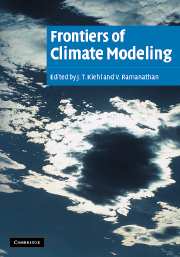Book contents
- Frontmatter
- Contents
- Preface
- List of Contributors
- Acknowledgments
- 1 Overview of climate modeling
- 2 Climate-change modeling: a brief history of the theory and recent twenty-first-century ensemble simulations
- 3 Energy-balance climate models
- 4 Intrinsic climatic variability: an essay on modes and mechanisms of oceanic and atmospheric fluid dynamics
- 5 The radiative forcing due to clouds and water vapor
- 6 A model study of the effect of Pinatubo volcanic aerosols on stratospheric temperatures
- 7 Unresolved issues in atmospheric solar absorption
- 8 Cloud feedbacks
- 9 Water-vapor feedback
- 10 Water-vapor observations
- 11 New frontiers in remote sensing of aerosols and their radiative forcing of climate
- 12 Cloud–climate feedback: lessons learned from two El Niño events
- 13 Runaway greenhouses and runaway glaciations: how stable is Earth's climate?
- Glossary
- Plate section
1 - Overview of climate modeling
Published online by Cambridge University Press: 12 August 2009
- Frontmatter
- Contents
- Preface
- List of Contributors
- Acknowledgments
- 1 Overview of climate modeling
- 2 Climate-change modeling: a brief history of the theory and recent twenty-first-century ensemble simulations
- 3 Energy-balance climate models
- 4 Intrinsic climatic variability: an essay on modes and mechanisms of oceanic and atmospheric fluid dynamics
- 5 The radiative forcing due to clouds and water vapor
- 6 A model study of the effect of Pinatubo volcanic aerosols on stratospheric temperatures
- 7 Unresolved issues in atmospheric solar absorption
- 8 Cloud feedbacks
- 9 Water-vapor feedback
- 10 Water-vapor observations
- 11 New frontiers in remote sensing of aerosols and their radiative forcing of climate
- 12 Cloud–climate feedback: lessons learned from two El Niño events
- 13 Runaway greenhouses and runaway glaciations: how stable is Earth's climate?
- Glossary
- Plate section
Summary
Earth's climate system
The study of Earth's climate system is motivated by the desire to understand the processes that determine the state of the climate and the possible ways in which this state may have changed in the past or may change in the future. The most comprehensive tool available to reach this understanding is the global Earth-system model. Earth's climate system is composed of a number of components (e.g., atmosphere, hydrosphere, cyrosphere, and biosphere). These components are non-linear systems in themselves, with various processes, which are spatially non-local. Each component has a characteristic time scale associated with it. The entire Earth system is composed of the coupled interaction of these non-local, non-linear components. Given this level of complexity, it is no wonder that the system displays a rich spectrum of climate variability on time scales ranging from the diurnal to millions of years. Chapter 4 explores issues of climate variability in more detail. This level of complexity also implies the system is chaotic (Lorenz, 1996, Hansen et al., 1997), which means the representation of the Earth system is not deterministic. However, this does not imply that the system is not predictable. If it were not predictable at some level, climate modeling would not be possible. Why is it predictable? First, the climate system is forced externally through solar radiation from the Sun. This forcing is quasi-regular on a wide range of time scales. The seasonal cycle is the largest forcing Earth experiences, and is very regular.
- Type
- Chapter
- Information
- Frontiers of Climate Modeling , pp. 1 - 25Publisher: Cambridge University PressPrint publication year: 2006
- 1
- Cited by



